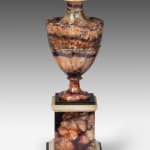George III Blue John Urn
ENGLAND, CIRCA 1780
42 x 14 x 14 cm
16 ½ x 5 ½ x 5 ½ in
16 ½ x 5 ½ x 5 ½ in
7127
Further images
The solid form comprising a lid with a ball finial, the vasiform body mounted on a stepped square Blue John, alabaster and Ashford black marble pedestal. Blue John's name derives...
The solid form comprising a lid with a ball finial, the vasiform body mounted on a stepped square Blue John, alabaster and Ashford black marble pedestal.
Blue John's name derives from the French 'bleu et jaune' (blue-yellow) and there is evidence of it being called Blue John from the 18th century in a letter by Matthew Boulton in 1768. Prior to that it was called Derbyshire Spar or Derbyshire Drop. It is a type of fluorspar, a semi-precious gemstone, which can present as almost any colour but in this case is of purple, white and gold bands. It is found only in Britain, mainly in the caverns of Treak Cliff at Castleton in the Peak District and is considered one of Britain's rarest minerals. Different parts of Treak Cliff hill are characterized by different patterns of colour banding in the mineral. The deposits are found in veins each with its own unique banding and colour. the types have been historically grouped into fifteen named veins including Millers, Treak Cliff Blue, Bull Beef, Winnats One, Old Dining Room, New Cavern, New Dining Room, Winnats 5, Odin, Old Tor and Ridley.
The Ashford black marble is mined at Ashford-in-the-Water, just a few miles away from the Blue John mines.
Blue John's name derives from the French 'bleu et jaune' (blue-yellow) and there is evidence of it being called Blue John from the 18th century in a letter by Matthew Boulton in 1768. Prior to that it was called Derbyshire Spar or Derbyshire Drop. It is a type of fluorspar, a semi-precious gemstone, which can present as almost any colour but in this case is of purple, white and gold bands. It is found only in Britain, mainly in the caverns of Treak Cliff at Castleton in the Peak District and is considered one of Britain's rarest minerals. Different parts of Treak Cliff hill are characterized by different patterns of colour banding in the mineral. The deposits are found in veins each with its own unique banding and colour. the types have been historically grouped into fifteen named veins including Millers, Treak Cliff Blue, Bull Beef, Winnats One, Old Dining Room, New Cavern, New Dining Room, Winnats 5, Odin, Old Tor and Ridley.
The Ashford black marble is mined at Ashford-in-the-Water, just a few miles away from the Blue John mines.






